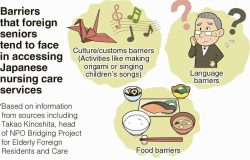
The Old Stuyvesant High School building on East 15th Street in New York
8:00 JST, December 10, 2023
The following is an installment of the “Letter from New York” column by Jacob Margolies, The Yomiuri Shimbun’s General Counsel for America. Having practiced law for over three decades in New York, he explores a variety of topics — cultural, economic and political — in and around the Big Apple, and examines issues that the United States, Japan and the world at large are facing.
Unlike other cities in the United States where the automobile is king, New York is great for walking.
While wandering the streets of the city over the last 50 years, I have observed New York’s transformations and how the physical city undergoes destruction, alteration and regeneration.

As a teenager in the 1970s, I witnessed decay as thousands of buildings were abandoned and burned down in the Lower East Side neighborhood where I lived, as well as in many other parts of the city. Over the course of a decade, New York’s population declined by nearly a million people. Entire neighborhoods were abandoned.
The causes of the decline are debated. There was, starting in the 1950s, a massive loss of manufacturing jobs, which moved south to states that paid lower wages. During this same period, an abundance of affordable new single-family housing that had been built in the suburbs after World II led many to flee the city.
The city’s loss of jobs and people were factors in a dramatically increasing crime rate and a fiscal crisis that led to a decline in basic municipal public services. In those years, in a beautification attempt that epitomized the city’s dire condition, the vacant windows of hundreds of abandoned tenements in the borough of the Bronx were covered with vinyl decals depicting curtains, shades, shutters and flowerpots.
All the housing that was lost has by now been replaced. But as the population has increased, there is now a terrible shortage of affordable housing. The city’s population, which was just over 7 million in 1980, was 8.8 million in 2020. Strolling along streets near my childhood home, which for 20 years were largely abandoned, one sees rows of modern buildings with condominiums that sell for over $1 million.
New York’s economy today is centered on finance, tech, education, health care, business services and tourism. During the years Michael Bloomberg was mayor, from 2002 through 2014, much of the city was rezoned. New neighborhoods of high-rise apartments and offices were constructed in waterfront neighborhoods, replacing warehouses and rising up over freight rail yards. At the same time, zoning changes in other parts of the city, especially affluent areas, prohibited the construction of large new buildings, ensuring that many neighborhoods would remain at the same scale.
A more sudden transformation to New York’s landscape commenced on Sept. 11, 2001, just before Bloomberg was elected. In the years since the attack on the World Trade Center, downtown Manhattan has been transformed. New office towers have been built, and several of Lower Manhattan’s iconic skyscrapers have been repurposed into apartments for residential living.
Just as there is churning and change, there are also many traces of the city’s history that remain. The often-quoted line of the famous 20th-century American novelist William Faulkner that “The past is never dead. It’s not even past” applies, even in a city as dynamic as New York.
The first European colonizers of Manhattan were the Dutch. Before New York, there was New Amsterdam, which from 1624 until 1664 was part of the Dutch Republic.
Stuyvesant High School, which I attended, is named after the last Dutch director-general of the city. Blocks from the apartment where I grew up is the famous Bowery, a street whose name is derived from an antiquated Dutch word for farm, “bouwerie.” The Bowery, originally a Native American footpath, leads into Cooper Union’s Great Hall, where Abraham Lincoln gave a speech that historians believe helped lead to his election in 1860. Many years later, Barack Obama would give a speech on the same spot.
Strolling four blocks east, I pass the building where I attended middle school. Constructed for the Children’s Aid Society by the great architect Calvert Vaux and built in the 1880s, the building originally sheltered and educated destitute working children, particularly newsboys and bootblacks. Later it became a Jewish day school, and today it houses apartments.
While these buildings and street names may seem like nothing more than remainders, they tell the story of the city, and their presence provides a sense of continuity and community.
The architecture of all great cities, unless they have become museum pieces frozen in time, reflects both the raw energy of transformation and large historic forces. This is certainly true of the landscape of modern Tokyo, which was redrawn by two terrible cataclysms of the 20th century. The 1923 Great Kanto Earthquake and ensuing fires resulted in the destruction of about 290,000 homes. The city was rapidly rebuilt and then largely leveled again by the Great Tokyo Air Raid by U.S. forces on March 10, 1945, which resulted in hundreds of thousands of buildings burned to the ground and the deaths of about 100,000 people. The rebuilding of the city after the war proceeded with a frenzied energy, culminating in the symbolic rebirth of Tokyo with the 1964 Olympics.
Tokyo’s approach to preservation and building has been very different than that of New York. In recent years many buildings in Tokyo, some only decades old, have been dismantled. In their place massive new skyscrapers are going up all over the city. This is a boom for Japan’s construction industry and ensures an impressive supply of new and modern residential and office buildings. But there are environmental downsides, and the constant churn, at least in the eyes of critics, is alienating and dehumanizing.
Tokyo’s 23 wards are home to around 9.8 million people, so the populations of New York and Tokyo are comparable. In regards to the physical city and housing costs, however, the two diverge drastically.
The most acute obstacle facing New York today is a lack of housing. Businesses are reluctant to expand because the cost of living in the city makes it difficult to attract new employees. Many residents spend over half their income on housing. A recent RAND Corporation report found that New York’s housing shortage has gotten much worse in recent years. The city added around 200,000 new residential units between 2010 and 2020. But the city’s population increased by around 630,000 over the same period.
On average, a one-bedroom apartment in New York rents for more than four times the cost of a similar apartment in Tokyo. When I recently asked a British friend who lives in the Japanese capital about his living quarters, I was astonished to hear he pays ¥81,000 ($550) a month for his small two-room apartment in western Tokyo. Such a bargain is unfathomable in New York. Finding a similar apartment in Manhattan on the open market even at four times that cost would be considered a terrific bargain.
So when it comes to addressing New York’s housing crisis, it seems state and city governments could learn from Tokyo.
In much of New York, especially in its greater metropolitan areas encompassing the suburbs, exclusionary zoning prohibits the construction of apartment buildings. Even in areas near train stations, many localities only allow single-family housing. New York City has 38,000 landmarked properties and 156 historic districts, and its restrictive building regulations, in some instances, reflect locals’ aversion to allowing people of lesser means to move into a neighborhood.
In Japan, by way of contrast, a national zoning law limits the ability of local areas to prohibit construction of new residential housing, and apartment buildings can be built in most areas. This has accommodated almost constant construction and kept Tokyo’s housing costs low compared with other world financial centers. And apartment prices have remained relatively affordable, even as the population of Tokyo’s 23 wards grew rapidly, adding nearly 2 million people over the last 25 years.
Developers in Tokyo and the metropolitan government are much more amenable than their counterparts in the U.S. to tearing down and replacing buildings. Unlike most American cities, which have one or two identifiable downtowns, Tokyo has many city centers clustered around its remarkably efficient and expansive train and subway system.
However, there is a downside to such constant tearing down and rebuilding. Unlike Paris or London or New York, there is little sense of continuity in much of Tokyo. As buildings are demolished, memory is lost. Of course, in the 20th century this was due in no small part to so much of the city being destroyed in World War II. Tokyo at that time had no choice but to start over.
New York City does have a choice. Sentimentality and nostalgia about tradition or maintaining a community’s character can have deleterious effects. In Tokyo, for better or for worse, the metropolitan government and builders have chosen a different path.
Here in New York, there are still reminders of the past. I’ll keep walking the city streets, observing what’s still standing and reflecting on what came before me.
"JN Specialities" POPULAR ARTICLE
-

The Japan News / Weekly Edition (12/12-12/18)
-

Noodle Dining Shunsai / Rich Oyster Ramen to Savor at Odasaga; Experienced 68-year-old Owner Creates Numerous Ramen Varieties
-

The Japan News / Weekly Edition (12/5-12/11)
-

People Keep Loved Ones’ Ashes Close in Special Jewelry, Small Urns as Unique Way to Memorialize Them
-

The Japan News / Weekly Edition (12/19-12/25)
JN ACCESS RANKING
-

Tokyo Economic Security Forum to Hold Inaugural Meeting Amid Tense Global Environment
-

Keidanren Chairman Yoshinobu Tsutsui Visits Kashiwazaki-Kariwa Nuclear Power Plant; Inspects New Emergency Safety System
-

Imports of Rare Earths from China Facing Delays, May Be Caused by Deterioration of Japan-China Relations
-

University of Tokyo Professor Discusses Japanese Economic Security in Interview Ahead of Forum
-

Japan Pulls out of Vietnam Nuclear Project, Complicating Hanoi’s Power Plans

























